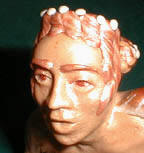FACE OFF
Eyeball width and how to measure the face with it.
Drawing: The Head and Figure
by Jack Hamm
ISBN# 0-399-50791-4
It was written in 1963 so the female nudes are in HIGH HEELS, all the ladies have lipstick and just about 1940 eyelashes. It's dated for sure with the hair dos and some of the sensibilities but what it says about eye width is just so useful for our sculpting.
On page 5 there's a disturbing picture. A face just criss crossed with eyes, to show how to proportion an "average" face. Rule of thumb only, mind you. But dig...
The distance between the eyes is one eye width.
When looking at the face from the front the space from the outer corner of the eye and the side of the face that one can see is one eye width, not counting lashes, just the exposed eyeball's width.
So you could string 5 eyes across an average face.
Take the two eyes and find their distance from one another from the outer eye to the outer eye. That distance is the same distance from the outer eye to below the lower lip, at the center. Nice triangle there.
The distance from the center of the eye to the side of the nose is one eye width, as is the lower part of the nose.
One eye width from the corner of the mouth, going out at an angle to the jaw.
One eye width from the lower lip to the chin.
The distance from under the eye to the top of the eyebrow, you got it, one eye width.
Using this eye width as a rule of thumb, and then you position the features you'll have a balanced face.
Now this is average. What happens if we upset this ratio?
Let's get animal about this. Animals who kill have eyes positioned towards the front of the head, makes targeting prey more accurate. Animals who are prey often have eyes to the side of their head for a wider range of view to look out for predators.
When you squeeze the eyes together on a human face, push them too close together you get a predatory look and one doesn't know why.
When you make the eyes big and off to the sides of the face the person looks bunny innocent and good enough to eat.
If you had a bunch of little features in a BIG FACE, this often spells comedy or medical problems. Depends on the rest of the scene.
If you had big features in a little face, it can be comical, like cartoon characters often have large eyes, big cheeks, think of Mickey Mouse and you got the idea.
Big face, little squinty eyes, placed close together, puckery lips high under the nose, makes you want to add a piggy snout and call it a day.
So when I go on about eye width as a general rule of thumb for placing features on a face use your judgment. But when you sculpt a face, take it to a friend, show it on the pix list and ask folks...what is this face telling you? What emotion do you think is going on? Don't tell folks what you intended. That's like explaining a poem and not letting a poem stand on it's own merit.
Show the faces you're sculpting and solicit response from your claymates. This way we can see what sort of emotional impact we're making with the faces we're sculpting.
Just showed James the face covered with eyeballs and he said, "Creepy". It is, but we're just going to use our clay tools or our finger tips to measure make pretend eyes. Silly goose man.
So that's it for EyeWidth for now and check it out on yourself, on your family. What exceptions to the rule do we have, like with children, babies, their ratios are different than from adults?
Let's kick this around.
xoxo
NJ
 Norajean.com
Norajean.com